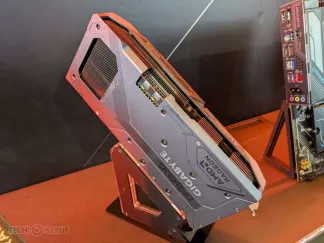AMD revealed its next-gen RX 9000 series graphics cards yesterday … well, kind of. The cards were mostly a no-show, with nothing but a promise that we’d hear more soon. However, AMD’s partners still showed off some of the upcoming RX 9070 XT and RX 9070 graphics cards during CES 2025, which is why we now know what they’re going to look like — though we still know very little about how they’ll perform when matched up against some of the best graphics cards.
Despite the lack of specifics during the presentation, Asus announced four RDNA 4 graphics cards with undisclosed release dates. Unfortunately, the only specification we got out of all this is that both the RX 9070 and the RX 9070 XT feature 16GB of VRAM, which is a healthy amount that can rival Nvidia’s $1,000 RTX 5080.

The lineup covers TUF and Prime models, and the TUF series offers a dual-BIOS switch. Asus is also replacing thermal paste with phase-changing thermal pads for improved heat dissipation, so these GPUs should stay nice and cool under pressure. However, we still don’t know how much power they’re going to consume. As such, it’s unclear how hot these GPUs will run in the first place. All cards will be factory-overclocked, but the base and maximum clock speeds haven’t been announced.
Based on the photos, we can also gather that all four GPUs will come with a triple-fan configuration. The Prime model comes with three 8-pin power connectors, and I’m assuming the TUF variant will use the same configuration. There are also three DisplayPort 2.1 ports and one HDMI 2.1 output.

Gigabyte also gave the public a glimpse at its upcoming RDNA 4 graphics cards, as shared by TechPowerUp. The company showed off the Radeon RX 9070 XT Elite and the RX 9070 Gaming OC. There’s also the Aorus RX 9070 XT Elite, which features a couple of new thermal management solutions, such as a redesigned Hawk fan. Gigabyte also offers dual BIOS modes.
During the actual keynote, AMD barely mentioned RDNA 4 and FSR4, but both are on the horizon, most likely launching within this quarter. However, prior to the keynote, the company shared a few slides with the press, which is why we now know that RDNA 4 will offer third-gen ray tracing accelerators, and that the lineup consists of the RX 9070 and the RX 9060. We also know that AMD is sticking to the mainstream market, as the flagship will only rival the last-gen RX 7900 XT.
It’s nice to see the upcoming GPUs in the flesh, and this makes me hopeful that it won’t be long before AMD tells us more about the RX 9000 series.





